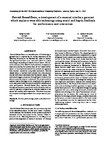Dervish Sound Dress; a development of a musical interface garment which explores wearable technology using sound and haptic feedback for performance and interaction
| dc.contributor.author | Hurban, H | |
| dc.contributor.author | Miranda, Eduardo | |
| dc.contributor.author | Braund, Edward | |
| dc.date.accessioned | 2018-11-02T11:49:23Z | |
| dc.date.issued | 2018-07-04 | |
| dc.identifier.isbn | 978-9963-697-30-4 | |
| dc.identifier.issn | 2518-3672 | |
| dc.identifier.uri | http://hdl.handle.net/10026.1/12716 | |
| dc.description.abstract |
Dervish Sound Dress is a wearable piece of technology; a garment that is inspired by the sacred experience of the Whirling Dervishes or the Mevlevi Sufi order in Turkey. The garment functions as an instrument when it is worn and changes depending on how the wearer moves. The cultural traditions of the Mevlevi Sufis and their metaphysical experience during the turning ritual of the 'sema' performance is the inspiration behind the creation of a garment that emulates sounds by using body movement. Dervish Sound Dress is outfitted with sensors that emit musical sounds with every movement that the wearer makes. The movement triggers sensations through haptic feedback like when a musician plays an instrument. The project seeks to explore how technology can be integrated into a garment as an expressive body instrument to amplify contemporary sonic performance. Dervish Sound Dress explores how through performance, sound and sound vibrations that are used in a garment can generate an emotive response in the wearer by creating sonic expression. This dress is accessible to anyone wishing to embark on a unique musical journey. | |
| dc.format.extent | 324-330 | |
| dc.language.iso | en | |
| dc.title | Dervish Sound Dress; a development of a musical interface garment which explores wearable technology using sound and haptic feedback for performance and interaction | |
| dc.type | conference | |
| dc.type | Conference Proceeding | |
| plymouth.date-start | 2018-07-04 | |
| plymouth.date-finish | 2018-07-07 | |
| plymouth.publisher-url | http://www.smcnetwork.org/#smc | |
| plymouth.conference-name | Sound and Music Computing Conference | |
| plymouth.publication-status | Published | |
| plymouth.journal | Proceedings for the SMC 2018 Sound and Music Computing Conference | |
| dc.identifier.doi | 10.5281/zenodo.1408596 | |
| plymouth.organisational-group | /Plymouth | |
| plymouth.organisational-group | /Plymouth/Faculty of Arts, Humanities and Business | |
| plymouth.organisational-group | /Plymouth/REF 2021 Researchers by UoA | |
| plymouth.organisational-group | /Plymouth/REF 2021 Researchers by UoA/UoA33 Music, Drama, Dance, Performing Arts, Film and Screen Studies | |
| plymouth.organisational-group | /Plymouth/Users by role | |
| plymouth.organisational-group | /Plymouth/Users by role/Academics | |
| plymouth.organisational-group | /Plymouth/Users by role/Researchers in ResearchFish submission | |
| dc.publisher.place | Limassol, Cyprus | |
| dcterms.dateAccepted | 2018-06-01 | |
| dc.rights.embargodate | 2019-4-11 | |
| dc.rights.embargoperiod | Not known | |
| rioxxterms.versionofrecord | 10.5281/zenodo.1408596 | |
| rioxxterms.licenseref.uri | http://www.rioxx.net/licenses/all-rights-reserved | |
| rioxxterms.licenseref.startdate | 2018-07-04 | |
| rioxxterms.type | Conference Paper/Proceeding/Abstract |


